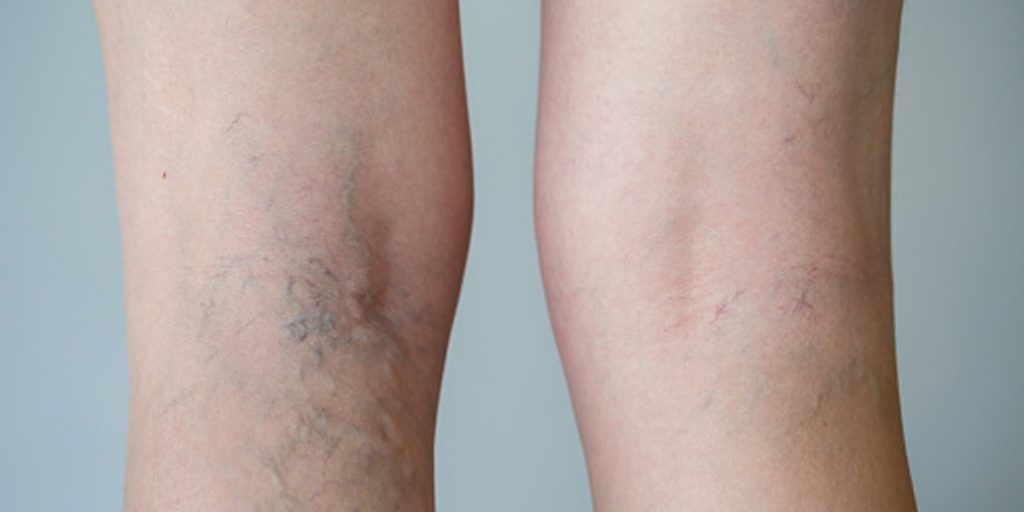For most patients, spider veins are nothing to worry about. They are not generally associated with a serious medical condition and usually cause no discomfort. But if you’re self-conscious about your spider veins, or if you have other cosmetic concerns about them, Premier Dermatology and Mohs Surgery of Atlanta offers treatment options that can eliminate their appearance. Treatments are quick, minimally invasive, and require no downtime.
What Are Spider Veins?
Spider veins are small purple, blue or dark red vessels that sometimes appear close to the surface of the skin. As their name implies, these veins are often spider-like, or web-like, in appearance. Some remain quite small, while others grow over time to become larger and more noticeable. They frequently present themselves on the face around the nose, cheeks, and chin as an individual ages.
These veins also sometimes develop on the inner thighs and behind the knees. They are more common in women than in men, in part because fluctuating female hormones can contribute to their development. They are also more common in older people.
Spider veins, known in the medical community as Telangiectasias, are essentially blood vessels that have become stretched and dilated over time. Unlike varicose veins, spider veins rarely cause discomfort. They are often a progressive condition, meaning they will likely grow in size and become more visible as you continue to age. But aside from cosmetic concerns, they don’t usually require medical treatment.
What Are the Risk Factors?
A number of risk factors contribute to the formation of spider-like veins near the skin’s surface. Some, like hormonal fluctuations and family history, are not factors patients have any control over.
Hormonal Fluctuations
Hormonal fluctuations — particularly in the female body — can impact the veins. Estrogen and progesterone, for example, can cause blood vessels to dilate and can loosen blood vessel walls, causing the valves in veins to become less effective.
Age
Age also takes its toll on veins, which tend to lose elasticity over the years. Additionally, the valves in veins can weaken as part of the aging process.
Excessive Standing or Sitting
Standing or sitting for long periods of time causes blood to pool in the lower part of the body rather than keeping it pumping up toward the heart as it should. Too much inactivity, combined with the effects of gravity, has a detrimental impact on the veins.
Obesity
Carrying excess body weight puts additional pressure on the veins and impacts their ability to carry blood back toward the heart.
Family History
Genetics play a huge role in vein health. The risk that a patient will develop varicose veins, for example, jumps significantly if the patient’s parents both have varicose veins.
Injury or Trauma
Veins — particularly those lying just beneath the skin — can become damaged as a result of a fall, a sports injury, or some other trauma.
Other Factors
Other risk factors also can contribute to vein health issues. Topical steroid use, birth control, liver disease, pregnancies, a history of blood clots, and previous vein surgery are among the factors that can play also play a role.
What Treatment Options Are Available?
Our practice offers a number of different vein treatments that are quick and painless, without the need for hospitalization or an extended recovery. Two treatments in particular — visually guided sclerotherapy and ultrasound-guided sclerotherapy — consistently yield positive results for spider vein patients.
Visually Guided Sclerotherapy
With visually guided sclerotherapy, the physician uses a fine needle to inject a solution into the spider vein that seals it off and causes it to close. After the treatment, the collapsed veins are absorbed into the body and other healthy veins take over and do the work the injected vein once did. Visually guided sclerotherapy is a minimally invasive, non-surgical treatment.
Ultrasound-Guided Sclerotherapy
Ultrasound-guided sclerotherapy is designed to first treat any underlying venous disease that may be contributing to spider veins. This type of sclerotherapy maps out any diseased veins and looks at how they connect to the deep venous system. Using the guidance of an ultrasound machine, a solution known as a sclerosing agent is injected into the diseased vein. This injection treats the diseased vein as well as any spider veins that connect to it, producing visible and long-lasting results with minimal risk.
Who Is a Candidate for Spider Vein Treatment?
Anyone who has spider veins on the legs or face and is bothered by their appearance is a candidate for these treatments. Most patients respond well to sclerotherapy treatments, see a noticeable decrease in the appearance of veins, and experience renewed confidence about their appearance.
Both the visually guided sclerotherapy and ultrasound-guided sclerotherapy treatments are performed at our office by Dr. Brent Taylor, who is certified by the American Board of Venous and Lymphatic Medicine in Phlebology as well as Board Certified in Dermatology. Minimally invasive treatments for other vein conditions are also available. Vein care has come a long way, and there’s no reason not to take care of this important part of your body.
If you’re ready to banish your spider-like veins and take the first step toward a refreshed look, while also improving your overall vein health, call Premier Dermatology and Mohs Surgery of Atlanta and schedule a consultation today. Most consultations and treatments are covered by insurance, and you’ll be on your way to clearer and healthier-looking skin in no time.

